They were the aristocratic Mad Men of the Cold War, the spies, politicians, and journalists sloshing back multiple martinis at lunch (and the world’s finest wine at Georgetown dinners), smoke ever-furling from lip to eye, all the while plotting to kill elected leaders, control dissident minds with LSD, and plant spies in European trade unions and American newspapers.

She was their Marilyn, an aristocratic blonde with knowing blue eyes, lissome moves, the softest curves, and sometimes, a velvet pouch with pot and acid at her side. “She was what woman were meant to be,” one former lover sobbed, still bereft 60 years later. Among her conquests was a man named Jack—John F. Kennedy to you and me. And like him, the story goes, she had to die before her time.
Her name was Mary Pinchot Meyer, and she lived and died in a gone world of monogrammed matchbooks, white-glove dances at Yale, yachting summers in the Med. She bewitched the blue-blooded men she ran with and who ran the world for a while, arrogant, entitled men who thought of themselves as poets and spies. One of them, her husband Cord Meyer, was both an accomplished short-story writer and, as the No. 3 in the CIA, one of the Right-est architects of the nascent security state .
She also dropped acid with Timothy Leary and painted abstract art with Kenneth Noland, but her greatest claim to fame is the tragic and mysterious way she died, shot twice at close range in a park in Washington, D.C., at age 43, 10 days after the Warren Commission report was released.
Her murder is one of Washington’s “enduring mysteries,” as the headline writers like to put it. Many have tried to solve it, including me. I concluded, as did the journalist Ron Rosenbaum before me, that Mary was most probably murdered by Ray Crump, the man police arrested within hours of the crime in the vicinity of the murder. He was identified by an eyewitness, then acquitted by an all-black jury in 1965, as racial tensions were rising not just in D.C., but nationally. The evidence against him was strong but circumstantial (no gun was ever found), but my investigation led me to believe Crump was entirely capable of violent behavior. His long post-acquittal record included stints in federal prison for repeat arsons and the rape of a 13-year-old. I met a former wife who was in hiding from him; she showed me a scar on her neck from a knife attack and described his strange and violent fugue states.
None of that extinguishes the rumors of conspiracy in this case, because Mary lived and died in a world of secrets, among powerful men whose day jobs were to plot—always with “plausible deniability”—the Bay of Pigs, the Iranian and Guatemalan coups d’etat, the assassination of Congo president Patrice Lumumba, and countless other known and unknown dark deeds.
When I was writing my book in D.C. in 1996 and 1997, I became aware of a cult of believers who were certain, absent any proof, that Mary had turned JFK on to LSD, and that she was behind the moves toward rapprochement with Russia and Cuba that he seemed to have been making in the months before he was killed. Mary Meyer had to die, the theory went, because she knew why “Jack” was killed, and maybe even—since CIA men were her friends and lovers—who was behind it.
In the last decade, newly available evidence is discrediting the lone-gunman theory of JFK’s assassination. It seems ever more probable that some combination of CIA-linked anti-Castro right-wingers and the mafia were involved.
Armed with this new information, and a lifetime certainty that Mary’s murder was a conspiracy, Peter Janney has produced a new book, Mary’s Mosaic, about her murder. He knows her world well because he grew up in it. His father was Wistar Janney, a CIA official, and, like Cord Meyer and Allen Dulles, an American blueblood from a wealthy family. Wistar Janney, along with many in his generation, served in World War II, came home and forsook the family patrimony of the boardroom to join the newly minted CIA’s covert war against communism.
Janney’s best childhood friend was Mary Meyer’s son. He also evidently had a childhood crush on this friend's mother, and subsequently grew obsessed with her murder, to the extent that he claims to have spent the last 35 years studying the case. His conclusion is that not only did the CIA mastermind Mary’s killing, but that his own father was involved. (Full disclosure, Janney optioned my book for a number of years, and, after failing to make a movie out of it, decided to write his own book challenging my conclusions.)
Janney is a quintessential insider—a generation removed—and he shares a number of similarities with many of the boomer children of Cold War spooks. (The most famous of them is of course, George W. Bush) Because the CIA at the time was completely off the books, many children thought their dads worked at the post office or someplace like it. But the men brought home the anxieties of Cold War–era spycraft, and in typical “Greatest Generation” WASP tradition, the stiff upper lip never softened. Alcohol was the bracer of choice.
I interviewed many of the spook kids for my book and found them often still struggling, years later, with the pain of having been raised in alcoholic households, plus carrying burdens of guilt over never really understanding, until after death, exactly what their dads had been up to. Many of them (like Janney, who is a licensed therapist in Boston) found solace in New-Age spirituality. The children of the notorious spy James Jesus Angleton (a sinister figure in the Meyer story and a character out of central casting who spent his days obsessively mole-hunting, and his downtime growing orchids and making trout flies) were not only completely estranged from their father, but retreated from the world to spend their lives on an ashram.
In the Georgetown of the Cold Warriors, the word “playdate” didn’t exist. Offspring were quickly dispatched to boarding school in New England, summers were spent sailing the Atlantic or the Adriatic with skippers who might have been CIA assassins, and no one asked Dad any questions at dinnertime. As Janney tells it, he rarely saw his father except as distorted through a glass of yellow liquid and ice. He didn’t get much tender parenting from a man whose favorite saying was “Opinions are like assholes. Everyone has one.”
Janney’s theory of Mary’s murder is that “she became a beacon for Jack as he explored a new trajectory after the near-calamity of the Cuban missile crisis” and was his partner, if not leader, in the peace-seeking behavior that inspired his assassination in the first place. He believes that the CIA, with his own father fully informed, ordered a “termination” on Mary in the days after the Warren Commission report came out, and hired an Army Special Forces assassin named William Mitchell, a self-identified Pentagon employee who testified at the trial of Ray Crump that he had been jogging and passed both Mary and behind her, Crump.
Janney bases his theory on the unpublished notes of a writer named Leo Damore, who, before he decided to venture into the Mary Meyer story, had written a best-seller about Ted Kennedy. He committed suicide in 1994 without writing the book, but before he died, Damore told a friend that Mitchell had actually confessed to him.
To believe this, one must accept that the CIA would hire a killer to “terminate” someone and then send that very same killer into court to testify at the murder trial. Furthermore, it seems that any writer worth his salt with a confession in hand would have been on the phone to the Washington Post the next day, shilling for his upcoming bombshell bestseller—or at least been popping the champagne with the book’s editor. Damore did not do that, but sank into a depression and ended up shooting himself in front of a cop and a nurse.
Janney suspects darker forces were at work, and that Damore may have been poisoned into depression by the CIA, another body in the long list of corpses who knew too much. He quotes an ex-CIA official saying that “anyone can commit a murder; it takes a real pro to commit a suicide.”
If Damore—and everyone who investigated Mary’s murder—had to die, as Janney suggests, I’m not sure why I was able to spend two years poking around in national-security archives and not just studying Freedom of Information Act documents but spending time at the CIA headquarters in Langley to interview every contemporaneous agent who was still alive, without ever being personally threatened. I would have loved to be the main character in my own James Bondette story. But the only stalking I encountered was from a drug-addled character obsessed with the theory that Mary was the Johnny Appleseed of acid and world peace who had to die.
Suicide was not uncommon among the Mad Men of the Cold War, and Janney makes much of the timing of the death of Washington Post publisher Phil Graham, whose suicide in the summer 1963 was preceded by a notorious breakdown in which he grabbed the stage at a gathering of national newspaper editors and, drink in hand, proceeded to call them all assholes, and reel off the names of women sleeping with Kennedy, before bursting into tears. For Janney, the unhinged newsman had to die, because the dark forces plotting to kill Kennedy knew they needed a compliant press for the cover-up.
One newsman who did survive those years was the father of Watergate, Ben Bradlee, a bit player in the Mary Meyer murder mystery. Bradlee was married to Mary’s sister Toni, and played a role in the search and subsequent disappearance of her diary. Shortly after Mary was murdered, Bradlee reported (years later, in his memoir) that he and Toni received a frantic call from one of Mary’s friends, the artist Anne Truitt, (whose alcoholic husband James Truitt also lost the plot, moved to Mexico, and later sold the story of Mary smoking dope with JFK to the National Enquirer) telling them to rescue Mary’s diary.
Superspook Angleton and Ben Bradlee ran into each other while breaking into Mary’s house to search for the diary that night or the following day, but no one ever told a straight story about exactly when they learned she was murdered, why they were at her house, and precisely when they arrived. Janney finds all this further proof of conspiracy. The fact is, it’s astonishing these people could remember who they had ordered assassinated, given the amount of alcohol they consumed at lunch.
Bradlee was plausibly involved in the diary search as a family member, but the fact that he waited more than 30 years to reveal his role in handing off a piece of possible evidence to the CIA in one of his town’s “enduring mysteries” says everything about his reputation as a great American journalist. Janney confirms what I and others who have studied the era have found, that Bradlee was mobbed up with the CIA, as were many of the most prominent Cold War journalists.
Angleton was the godfather of Mary’s sons, and so perhaps had some nonofficial reason for sneaking around her house. But Angleton had made a practice of stealing away with the papers of dead CIA agents around the world, including the CIA’s Mexico City station chief who had interacted with Oswald.
The diary is the MacGuffin in this incredible tale. Bradlee claims it was just an artist’s notebook, filled with color swatches and a few notes that referred to an affair with the President, and that he handed it off to Angleton for safekeeping. Toni later told reporters that she burned it.
Janney thinks the document contained a whole lot more than paint swatches, maybe even a treasure map leading to who killed Kennedy. He contends, without much evidence, that in the year after JFK’s assassination Mary “made it her business to learn what had really taken place in Dallas that late November day.”
Back to Crump. Janney’s theory is that if Crump went on to a life of crime after his acquittal, it was because he suffered PTSD from his nine months in jail and trial for murder as an innocent man. He also suggests that there was no way his lawyer (a black preacher, one of the few female criminal defense lawyers in D.C. at the time) would defend a guilty man, when in fact, that’s what defense lawyers do. When I interviewed her, she suggested that she had defended clients “with blood on their hands” and that as long as they “forgive themselves” they were forgiven in God’s eyes.
Janney is a real insider, and his opinion—contrary to what his dad would have told him—is worth our attention. The full story of what the CIA was up to in those years may never be told, but Janney (a Princeton man, as he informs readers early on) gives it the old college try. (He’s so convinced that he plans to ask U.S. Attorney General Eric Holder to reopen the murder investigation.) He has pulled together enough of the newly available evidence on JFK’s assassination to be convincing on the JFK assassination conspiracy. And it is entirely possible that the CIA wanted to shut up Mary Meyer, and went on to kill by suicide (or induced heart attack, or brain tumor, as Janney also suggests) untold numbers of other Americans who were onto them. Like Janney, we can only see that world through our own relatively childlike eyes—looking backward into the mists of time, at these giant men who controlled our world for a time, and who wielded such ghastly unchecked power. But proof of the web between the greasy killers in Dallas, their white-shoe puppet-masters in Washington (Janney’s father among them, if the son is to be believed) and the murder of the ultimate dangerous blonde, Mary Meyer, may always remain tantalizingly out of reach.






